Growing chives? Harvest the flowers and make chive blossom vinegar! Use this floral vinegar in a homemade vinaigrette or with roasted vegetables.
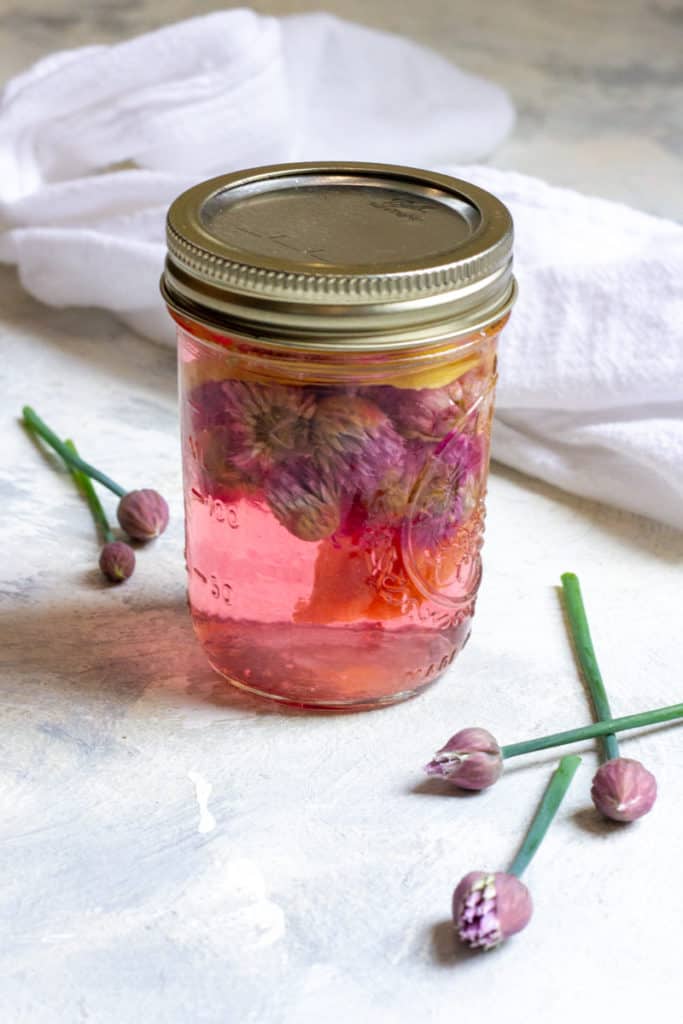
Spring came a little late this year, but it's finally here!
And happily, our chives are in full bloom!
You might already know that I adore edible flowers.
I love picking wild honeysuckle and making honeysuckle simple syrup and honeysuckle vodka.
When the zucchini plants begin to bloom, I rush out and pick flowers to make stuffed squash blossoms. And of course, I put lavender simple syrup in all the things.
So, of course, when the purple chive blossoms burst into life this year, I was on it. And I knew what had to happen.
Chive blossom vinegar, of course!
If you're looking for even more chive ideas, try making chive (+ chive blossom!) butter.
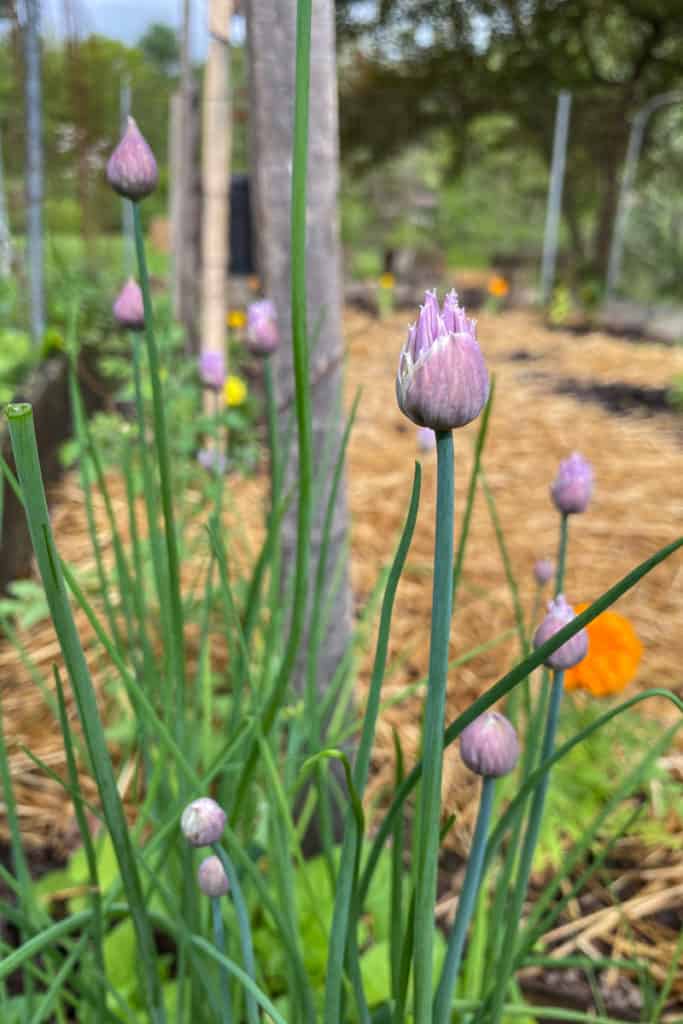
Identifying Chives
If you planted chives in your garden, then you probably don't need to spend much time positively identifying the chives.
However, if you're harvesting wild chive blossoms, here's what you should look for.
Chives (A. schoenoprasum) are a variety of wild onion.
Like other onions, they have tall, grass-like basal leaves and umbel-shaped flowers. The green leaves will have a strong onion scent.
Chives have hollow leaves and long, sharply pointed lavender flower petals.
When in bloom, chives have no poisonous look-a-likes.
However, when not in bloom, any type of onion could be mistaken for the highly poisonous death camas (Zigadenus nuttallii), especially if you're not an expert. Since you'll be harvesting the blossoms, this shouldn't be a problem here, but I think it's worth knowing!
For more help identifying wild flowers, I recommend the National Audubon Society Field Guide to North American Wildflowers.
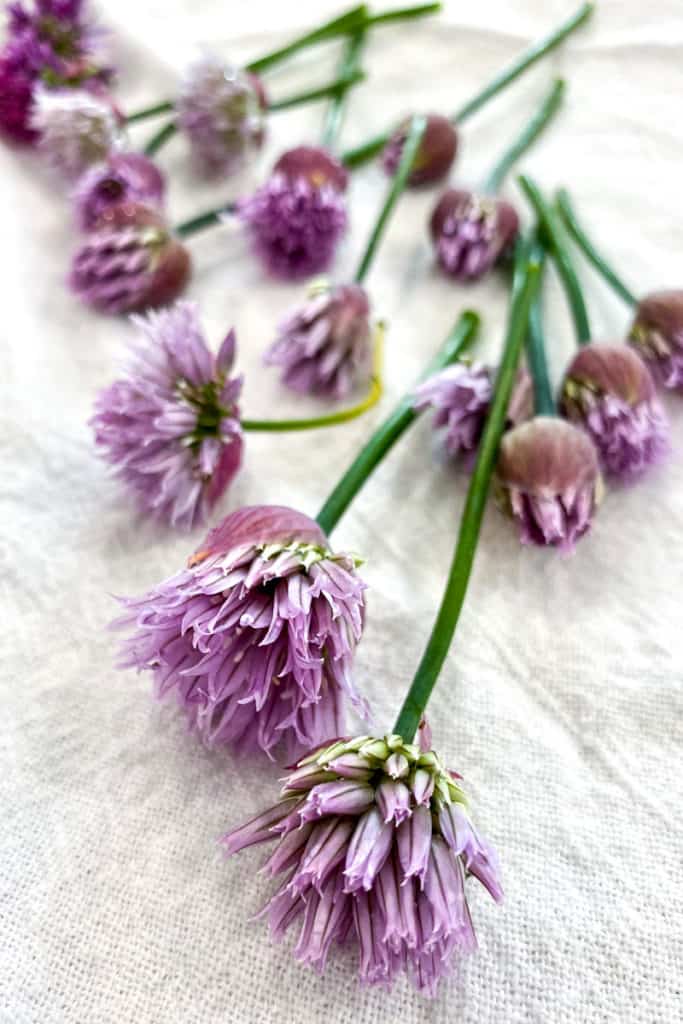
Harvesting + Cleaning Chive Blossoms
Use garden shears to snip off the chive blossoms.
I think it's easiest to snip them several inches below the flower so that you can use the green chive as a handle while cleaning.
Next, dip the chive blossoms in (room temperature or cold) water to clean them. The water will help get rid of any bugs hiding in the flowers.
Avoid placing the flowers under running water, because you could damage the blossoms.
Lay them on a towel to dry.
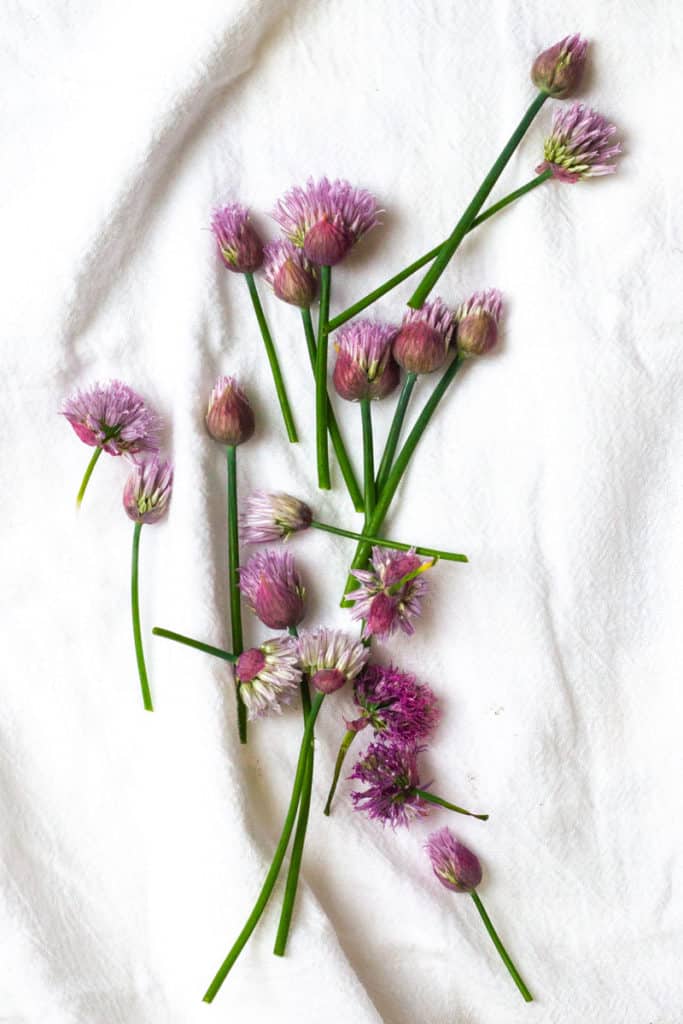
What Type of Vinegar Should I Use?
I recommend using either white wine vinegar or champagne vinegar.
White wine vinegar should be easy to find at any grocery store. Champagne vinegar is a little harder to find (and pricier), but is lovely if you can find it!
I don't recommend using strongly-flavored vinegars (like apple cider, sherry, or red wine vinegar) because those vinegars will likely overpower the flavor of the blossoms.
That said, if you have a lot of extra chive blossoms on hand and want to try making this with a strongly-flavored vinegar, go for it, and then let me know how it turned out!
If you want to use rice vinegar or homemade vinegar, you should infuse the chive blossoms in the refrigerator instead of at room temperature. Expect your refrigerator infusion to take longer than a room temperature infusion.
Rice vinegar typically has an acidity level below 5%, so if you're infusing it with "wet" ingredients like flowers (as opposed to dehydrated or fully dry flowers), keep it cool to avoid bacteria growth.
Avoid using distilled white vinegar! It's strong astringent flavor will ruin the flavor of your blossoms.
How to Make Chive Blossom Vinegar
Start by cutting off the green chives from the blossoms.
Alternatively, if you want your vinegar to have a stronger onion flavor, you could leave some of the chives attached.
Place the flowers in a clean glass jar. The jar doesn't have to be sanitized, but at minimum, wash it with hot, soapy water.
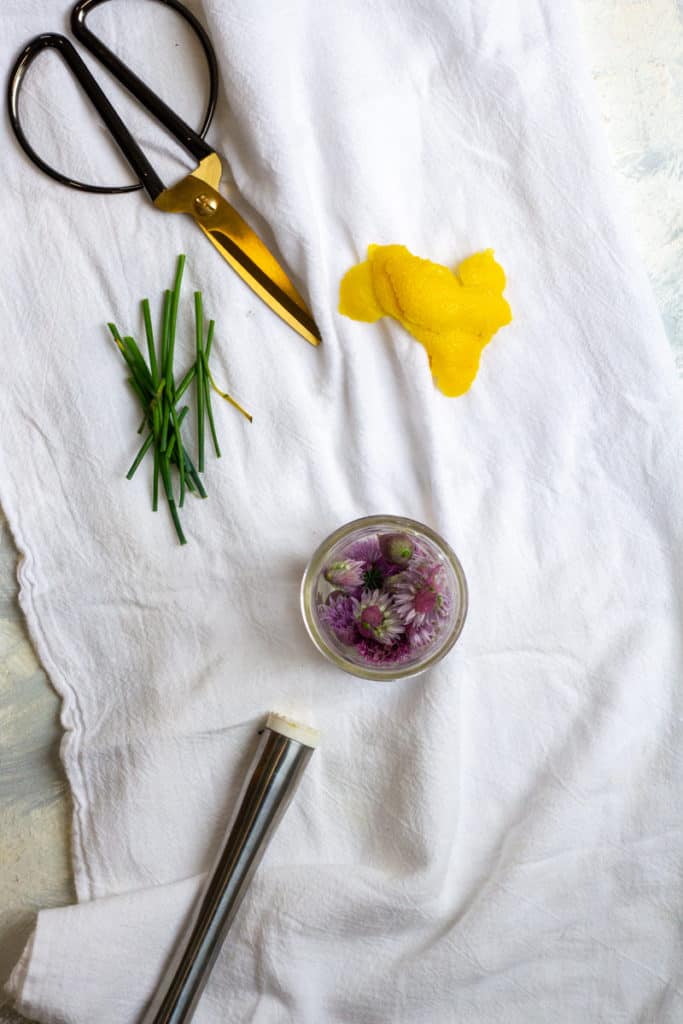
Next, muddle the flowers to release some of their flavor.
I used a cocktail muddler, but you can also use the back of a wooden spoon or a pestle.
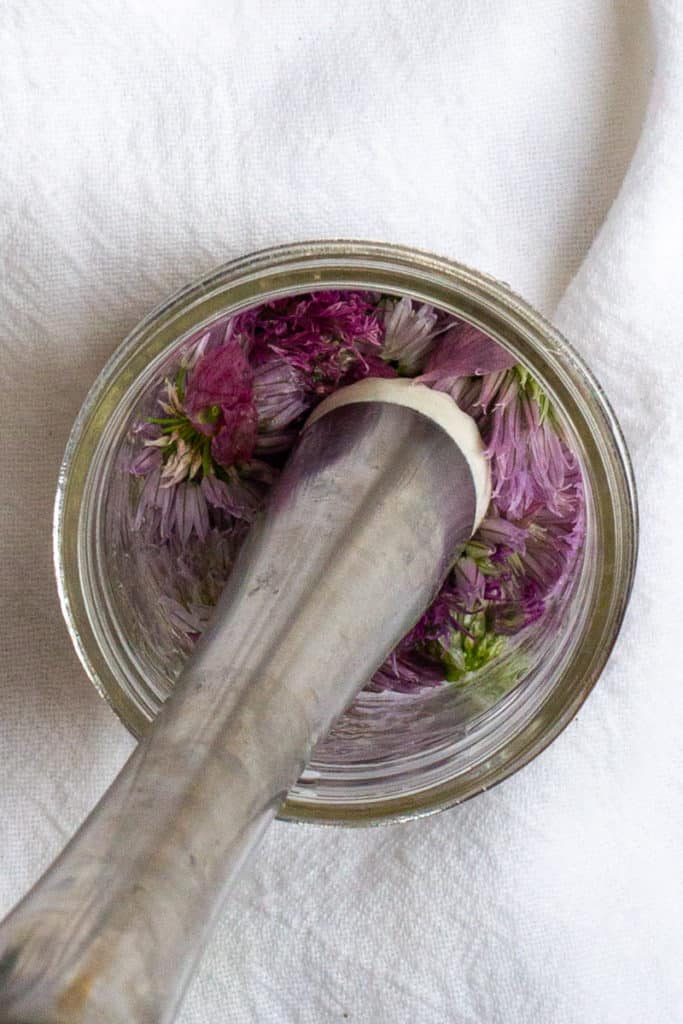
Infusing with Room-Temperature vs Warm Vinegar
At this point, you have two options.
Option one: Warm the vinegar up before pouring it onto the flowers.
Using warm water will speed up the infusion process, meaning you could use your vinegar in as few as three days.
Option two: You can choose to simply pour room-temperature vinegar into the jar with the flowers. This option will take longer to infuse (about 3-5 weeks), but will yield a slightly milder, more delicate finished product.
There is not a right or wrong option.
If you're in a hurry, use warm vinegar. If you're not, use room-temperature vinegar. Or try both to see which you prefer.
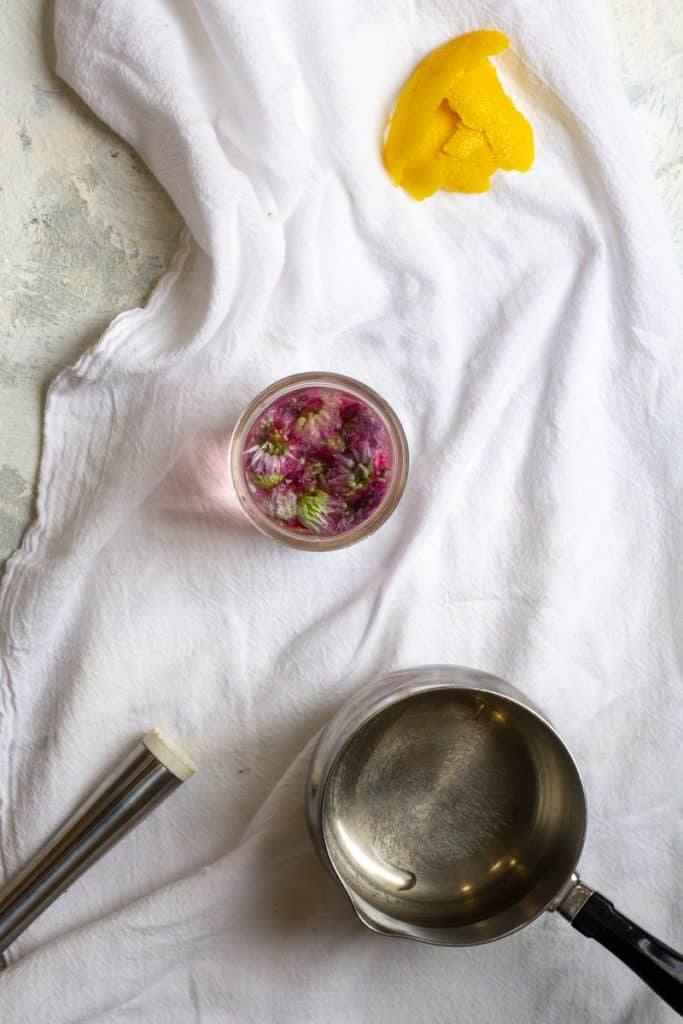
Pour the (room-temperature or warm) vinegar over the blossoms.
Next, top them with a few pieces of lemon peel. The peel will help hold down the blossoms, and will give the vinegar a little citrus flavor.
Next, seal the jar.
Keep in mind that the acidic vinegar will cause metal lids to corrode, so if you're using a metal lid, place a piece of wax or parchment paper between the vinegar and the lid.
And then, it's time to wait. Check on the vinegar daily to ensure that the blossoms are below the liquid, and let it infuse until you like the flavor.
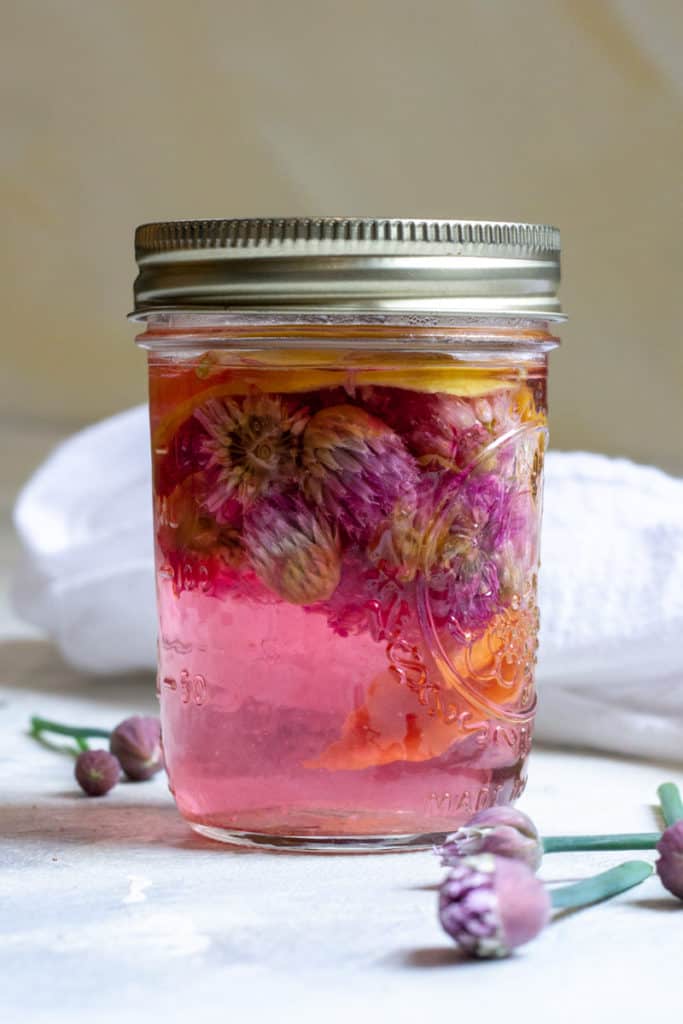
When it's ready, strain out the blossoms and lemon peel, and store the vinegar in the fridge.
How to Use Chive Blossom Vinegar
This floral, herbal vinegar has a delicate, mild onion flavor.
Try swapping it for any vinegar in a homemade vinaigrette, drizzle it over roasted vegetables (like roasted potatoes or roasted asparagus), or try swapping it for the vinegar in this potato salad!
This recipe was inspired by the vinegar infusions in Emily Han's book Wild Drinks and Cocktails.
Chive Blossom Vinegar
Ingredients
- ½ cup chive blossoms (fully open or partially open, both will work)
- ¾ cup white wine vinegar OR champagne vinegar
- peel from about half a lemon (preferably organic)
Instructions
- Clean the flowers by dipping the chive blossoms into a bowl of water, and set aside to dry.Optional: Heat the vinegar until it's warm. Do not bring it to a boil.Tip: Heating the vinegar will help the blossoms infuse more quickly, but will produce a slightly less delicate flavor than room temperature vinegar.
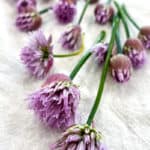
- Use kitchen shears to remove any green chives from the flowers. Add the flowers to a clean glass jar, and muddle them with a cocktail muddler or the back of a wooden spoon.
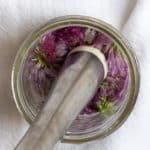
- Pour the vinegar over the flowers into the jar until the jar is almost full. (The amount of vinegar listed is approximate, you may need slightly more or less.)Place the lemon peel on top of the flowers to help keep them submerged.
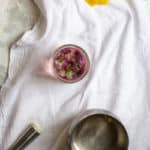
- Seal the jar, and place it in a cool place out of direct sunlight. Check on the vinegar daily to make sure the blossoms are still submerged.Allow the blossoms to infuse for anywhere from 3 days (if you used warm vinegar), or 3-5 weeks (for room temperature vinegar), until you like the flavor. Note that even warm vinegar infusions can be infused for 3-5 weeks. It all depends on your flavor preferences.Finally, strain out and discard (or compost) the blossoms and lemon peel. Store the vinegar in a sealed jar in the fridge, and use within 6-8 months.
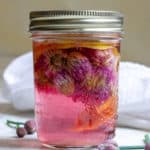
Notes
Use the measurements as a guide, not a rule. In general, pack the chive blossoms into a jar and fill the jar with vinegar. If you use more blossoms your infusion will be stronger, and fewer blossoms will give you a milder infusion.
Do not double or triple the lemon peel. While it will add some flavor, its main job is to hold the flowers under the liquid. Vinegar Substitutions:
I recommend using white wine or champagne vinegar.
If all you have on hand is apple cider vinegar, it will work, but the flavor of the chive blossoms will be less distinctive (because ACV has a strong flavor).
If you use rice vinegar, you should infuse the vinegar in the fridge and expect the infusion to take slightly longer. Rice vinegar's lower acidity level makes it unsafe to infuse at room temperature.
Avoid using white distilled vinegar, because it's too astringent-tasting.

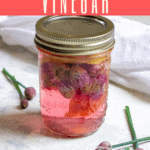
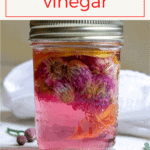
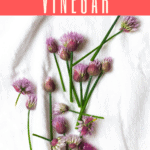
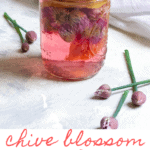
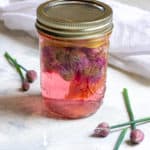

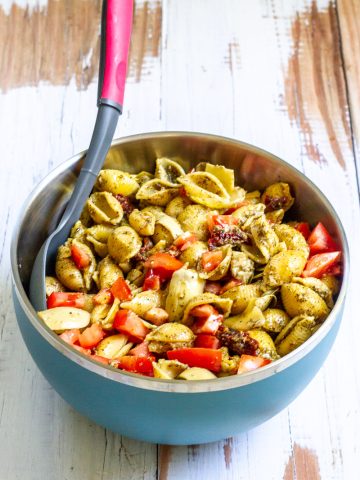
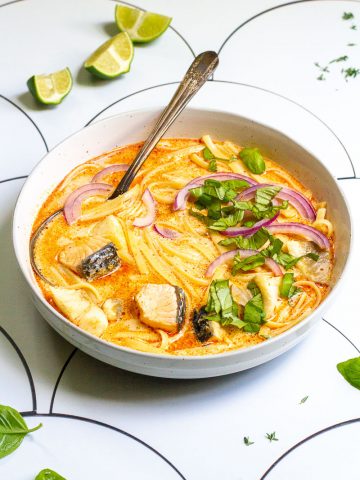
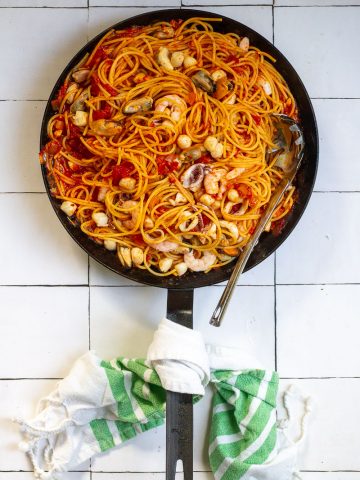
Gail
It’s possible to make with garlic chives which blossom in late summer/early fall and are white in color.